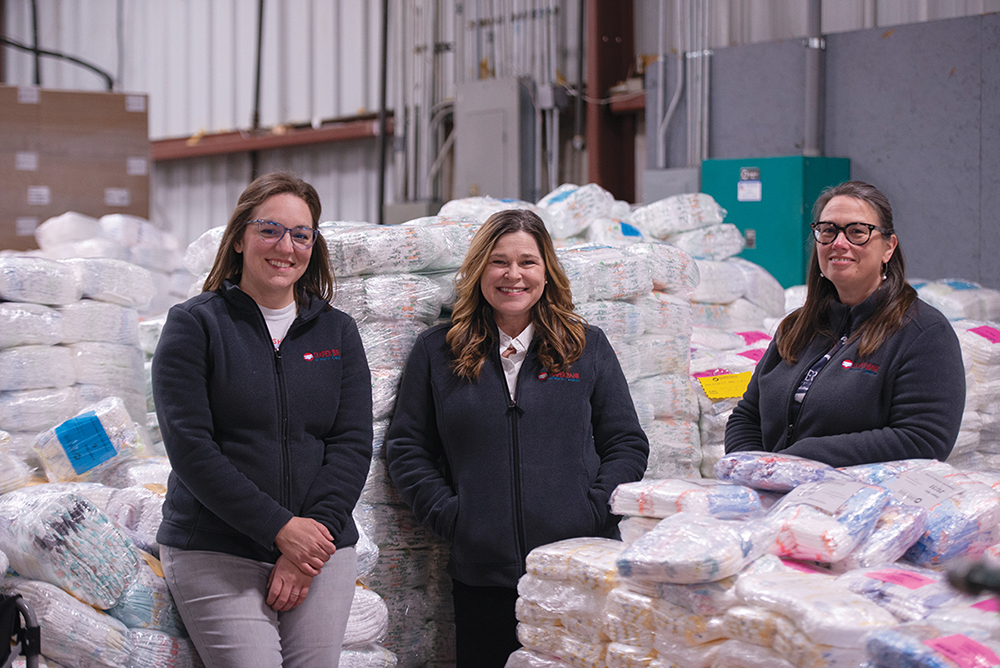Founded in 2013 by Michelle Old, this organization distributes diaper and hygiene products to babies, teens, women and seniors.
by Lord D.R. Wiggins | photography by Tyler Cunningham

Once a week, every week, for a few hours each time, Kathy Hohneker heads to a cold but vibrant 12,000 square- foot warehouse in Durham. There, she packages up diapers, sanitary napkins, panty liners, tampons and adult diapers into bundles of 10 or 25, to be added to packages of other necessities.
It’s a neighborship that this retired nurse has practiced for six years and counting, ever since she learned about the Diaper Bank of North Carolina at an event in Fayetteville. “After I retired, I wanted to continue to serve my community,” says Hohneker. “This serves a very important need — it’s my way to give back and help my neighbors.”
The Diaper Bank of North Carolina is a portal for diaper distribution into homes and onto babies’ bottoms, as well as for personal hygiene items for teens, women and seniors. It was founded by Michelle Old in 2013. That was the year she adopted her youngest son.
“When he came to us at one day old, he was very sick,” she says. “His body could not fight infections.” That meant frequent diaper rashes and other infections, hospital stays and 30 to 40 diaper changes a day. Those costs added up quickly.
Old had previously worked for the North Carolina Coalition Against Sexual Assault and as a legal advocate for the Durham Crisis Response Center.
Her diaper bills made her reflect on the women she’d met through work, many of whom had far less means than she. “I thought, How do families manage this?” Old says. “No family should have to struggle for basic hygiene items.”
The National Diaper Bank Network says that a healthy baby goes through six to 10 disposable diapers each day, which costs an estimated $70 to $80 per month. But diapers aren’t covered by federally funded health and nutrition programs.
Old learned one in three families can’t afford enough diapers, forcing them to use only one diaper all day or to reuse diapers, making children prone to everything from diaper rashes and chafing to yeast and bladder infections due to long-term exposure to toxins from their own waste.
Parents can miss work or school if they don’t have diapers to provide to daycare, and they experience stress and depression and shame. “If a person cannot afford food, they can’t afford hygiene items,” Old says. “Parents are making really tough decisions they shouldn’t have to make.”
Old formed the Diaper Bank with a goal to provide 50,000 diapers in her community within a year. Now, the Diaper Bank has distributed more than 23 million diapers statewide with branches in the Triangle, Triad, lower Cape Fear and Charlotte.
Diapers are distributed three ways: through open partnership (providing diapers to anyone who goes to a partner agency for them); closed partnership (with availability only to the clients of partner agencies); and by way of its Mobile Diaper Bank, a program that takes diapers by van to high-need neighborhoods.
With the three systems combined, the organization serves a total of 50 North Carolina counties. “We are one of the largest diaper banks in the country,” says Old, who has co-authored articles about diaper needs to fill the void of published research on her work.
Last year, the Diaper Bank distributed over 3 million diapers through social service agencies like Oak City Cares, Catholic Charities, Brown Bag Ministries, Step Up Ministry and others that serve families and women with children. This year’s target: 7.5 million. Depending on the region, that’s between about 50 to 200 diapers to each location per month, she estimates.
On average each month, the Diaper Bank provides 50 diapers per child, 20 sanitary items per woman, and 30 incontinence items per person. Old says it’s a formula based on research that shows families in need lack about 12 diapers per week. “We can’t provide all the diapers they need, but we can help,” Old says. “We can fill the gap.”
In 2014, Old added period products to the Diaper Bank’s distribution. She’d heard from middle- and high-school teachers about students who would miss school because they didn’t have supplies they needed to care for their menstruation.
“No one should have to miss school because they’re having a period,” Old says. She also created Period Power, a school-based program to encourage student-led drives for period products and distribution.
The Diaper Bank is now helping provide pads, panty liners and tampons to over 200 schools in 40 North Carolina counties. The Diaper Bank has also started distributing incontinence supplies, helping seniors stay dry and healthy, too. “Our work is about distributing dignity in all seasons of life,” Old says.
The Diaper Bank gets a majority of its supplies through donations from drives by community organizations and churches, as well as from financial contributions from individuals, foundations and grants. Even so, the demand can outpace projections. Last year, for example, Old says the projected budget was $65,000. The Diaper Bank spent $365,000, but donations were able to cover the difference.
Like many organizations, the pandemic tested the Diaper Bank’s value and viability. Since the pandemic, Old says, there has been a 400% increase in diaper requests and an 800% increase in requests for period products. Requests for incontinence supplies have also risen 2,000%. “It’s a blanket increase of need, not a certain area or region,” she says. “I’m so proud of my team: We have not missed one distribution.”
Hohneker helped. She stopped by the Diaper Bank several times a month during the first year of the pandemic when it was closed for volunteer work to pick up supplies. At home, she repackaged boxes of 150 diapers to bundles of 25, wrapped them in plastic and dropped them back off at the warehouse. Another couple, both of whom volunteer for the organization, together wrapped 455,000 diapers at home during the pandemic, Old says.
“Volunteers and staff turned their homes into wrapping centers,” she said. “It changed the whole way we served the community at that time.”
Welcome Baby, an organization that supports expecting mothers and parents of young children, was the first community organization to partner with the Diaper Bank as a distribution site.
“If the Diaper Bank were not around, there would be a lot less diapers for us to distribute,” says its program coordinator, Patience Mukelabai. “Welcome Baby also distributes feminine products, diaper cream, baby shampoo and sometimes formula,” she says. “We are able to more efficiently serve our families because we can count on the Diaper Bank to have the supplies we need.”
Studies show easing financial stress in just this one area helps in myriad ways. It boosts parents’ mental and emotional health, which leads to increased communication with partner agencies.
That allows those partner agencies to give clients even more support around jobs, parenting skills, housing and other community resources. “The relationship we have with the Diaper Bank has been really beneficial to our families,” Mukelabai adds. “It helps us take away the headaches.”
Old is ready for growth — she’s working toward moving into a larger warehouse and adding full-time staffers to the team. She’s grateful for a “steady” pool of 400 to 600 volunteers that support the Diaper Bank.
Hohneker credits Old along with the dedication and kindness of her team for keeping herself and other volunteers involved. “I credit the Diaper Bank for its vision, and it’s really easy to commit to going back,” Hohneker says. “The more we can help people, the more they are able to live a fuller life.”
“Thankfully, people love wrapping diapers,” Old says.
This article originally appeared in the May 2023 issue of WALTER magazine.





